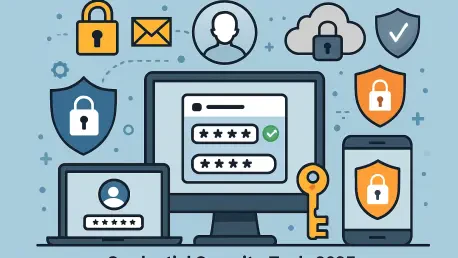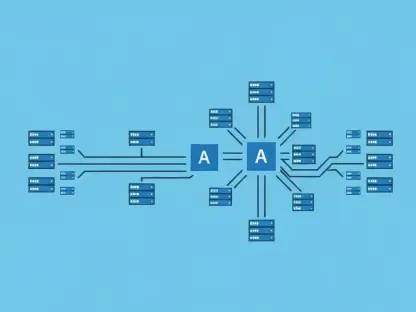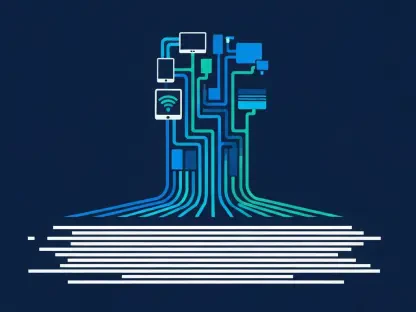In an era where cyber threats loom larger than ever, safeguarding sensitive login information stands as a critical priority for individuals and organizations across the globe. Compromised credentials—whether stolen usernames, passwords, or access tokens—represent a gateway for cybercriminals to orchestrate devastating attacks, from account takeovers to massive data breaches that can cripple businesses and erode trust. As attackers leverage sophisticated methods like phishing, malware, and dark web marketplaces to exploit these vulnerabilities, the demand for cutting-edge security solutions has skyrocketed. This article delves into five standout credential security tools shaping the landscape in the current year, each offering innovative approaches to detect and neutralize risks before they spiral into crises. By exploring their unique features and the broader strategies needed to combat credential theft, this piece aims to equip readers with the knowledge to protect digital assets in a threat-laden environment. The focus remains on proactive defense, real-time monitoring, and actionable insights that can make a tangible difference.
The Urgency of Credential Protection
The magnitude of credential compromise as a cybersecurity challenge cannot be overstated, especially given the alarming frequency and impact of data breaches today. Cybercriminals employ a range of tactics—phishing schemes, malware infections, and automated credential stuffing attacks—to harvest login details, which often end up for sale on illicit dark web forums. Once exposed, these credentials become tools for unauthorized access, leading to financial losses, regulatory fines, and severe reputational harm for businesses of all sizes. The ripple effects extend beyond immediate damage, threatening customer confidence and long-term operational stability. Addressing this pervasive issue requires more than just reactive measures; it demands a forward-thinking approach that anticipates threats before they materialize. Understanding the scale of this problem is essential for any organization aiming to fortify its defenses against an ever-evolving array of cyber risks.
Moreover, credential security serves as a linchpin for broader cybersecurity frameworks, intertwining with compliance mandates and business continuity plans. A single breach can trigger a cascade of legal and financial repercussions, making it imperative to prioritize robust protective mechanisms. The tools designed for the current landscape go beyond mere detection of exposed data; they integrate seamlessly with existing systems, offer real-time alerts, and provide actionable guidance to mitigate risks swiftly. This proactive stance is vital in an environment where attackers continuously refine their methods to exploit human error and technological gaps. By embedding credential protection into the core of security strategies, organizations can better safeguard sensitive information, ensuring they remain resilient against threats that could otherwise undermine their operations or public standing.
Leading Solutions in Credential Defense
Among the array of tools available to counter credential theft, Lunar by Webz.io emerges as a frontrunner with its unparalleled dark web monitoring capabilities. Leveraging artificial intelligence, this solution scours underground channels, encrypted forums, and paste sites to unearth exposed login details, delivering real-time alerts to security teams. What sets it apart is its ability to contextualize and de-duplicate data, cutting through irrelevant noise to highlight critical threats that demand immediate attention. Its API-first design further enhances its appeal, enabling smooth integration into automated security workflows for organizations seeking efficiency. This tool proves especially valuable for enterprises managing vast digital footprints, ensuring that potential vulnerabilities are identified and addressed before they can be exploited by malicious actors lurking in the shadows of the internet.
Another standout is Flashpoint, which combines advanced technology with human intelligence to tackle credential compromise at its roots. By engaging directly with underground communities, it uncovers insights that purely automated systems might miss, linking exposed credentials to specific threat actors or campaigns for deeper threat analysis. This dual approach of machine-driven monitoring and human-centric investigation adds significant value, particularly for large-scale security operations that require a nuanced understanding of cybercriminal behavior. Integration with orchestration platforms further streamlines its use within existing frameworks, making it a versatile choice for teams aiming to stay ahead of sophisticated attacks. The emphasis on correlating data with real-world threat intelligence ensures that organizations can respond with precision, minimizing the window of opportunity for attackers to strike.
Completing the lineup are three equally innovative tools, each bringing distinct strengths to the table. IdentityForce caters to a wide audience, from individuals to enterprises, by monitoring not just credentials but also personal data like Social Security Numbers, paired with user-friendly remediation steps. Pentera adopts a unique offensive strategy, simulating real-world attacks with discovered credentials to expose vulnerabilities before they’re exploited, offering proof-based validation for security fixes. Lastly, Bitdefender integrates dark web scanning into a broader security suite, combining endpoint protection with accessible interfaces for both IT teams and end-users. These solutions collectively address diverse needs, ensuring that whether an organization is small or sprawling, there’s a tailored approach to fortify against credential-based threats in today’s digital battleground.
Building a Comprehensive Security Strategy
While the aforementioned tools offer powerful defenses against credential theft, relying solely on technology falls short of a complete solution in the face of multifaceted cyber threats. Implementing strong password policies, enforcing multi-factor authentication (MFA), and exploring passwordless options like passkeys are fundamental steps to minimize exposure. Additionally, regular access audits help identify and revoke unnecessary privileges, while employee training programs target human error—a frequent entry point for attackers via phishing or careless data handling. Adopting an “assume breach” mindset pushes organizations to proactively hunt for leaks, utilizing both enterprise-grade tools and public resources to stay vigilant. This layered approach ensures that even if one defense fails, others stand ready to mitigate the impact of potential compromises.
The implications of credential security extend well beyond technical boundaries, influencing customer trust, regulatory adherence, and overall business health in profound ways. A breach involving stolen login details can shatter client confidence and invite legal scrutiny, underscoring the need for a holistic defense framework. Combining cutting-edge tools with preventative measures and rapid response protocols creates a resilient shield against threats. The future of protecting sensitive data hinges on fostering a culture of security awareness at every organizational level, ensuring that employees and stakeholders alike understand their role in safeguarding information. By aligning technological innovation with human vigilance, businesses can navigate the complex threat landscape more effectively, turning potential weaknesses into fortified strengths that deter even the most determined cybercriminals.
Reflecting on the Path Forward
Looking back, the journey through the landscape of credential security reveals a persistent and evolving challenge that demands innovative responses from the industry. The five tools spotlighted—Lunar by Webz.io, Flashpoint, IdentityForce, Pentera, and Bitdefender—stand out for their distinct contributions, from AI-driven dark web monitoring to offensive attack simulations that expose hidden flaws. Each solution addresses a facet of the credential theft problem, providing organizations with options to match their specific vulnerabilities and operational scopes. Their integration of real-time alerts and actionable intelligence marks a significant stride in reducing the window for attackers to exploit stolen data, reflecting a shift toward proactive rather than merely reactive cybersecurity.
Moving ahead, the focus should pivot to actionable next steps that build on these technological advancements. Organizations are encouraged to pair these tools with robust policies and ongoing education initiatives to address human vulnerabilities that technology alone cannot solve. Exploring integrations with broader security systems like SIEM and SOAR platforms could amplify effectiveness, creating a seamless defense ecosystem. Additionally, staying attuned to emerging trends, such as the adoption of passwordless authentication, promises to further diminish risks over the coming years from now to 2027. By fostering a mindset of continuous improvement and adaptation, businesses can transform the insights gained from these tools into lasting fortifications against the relentless tide of cyber threats.









